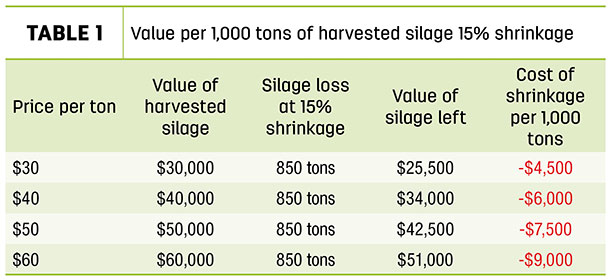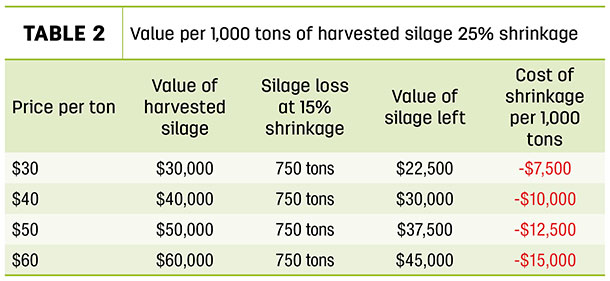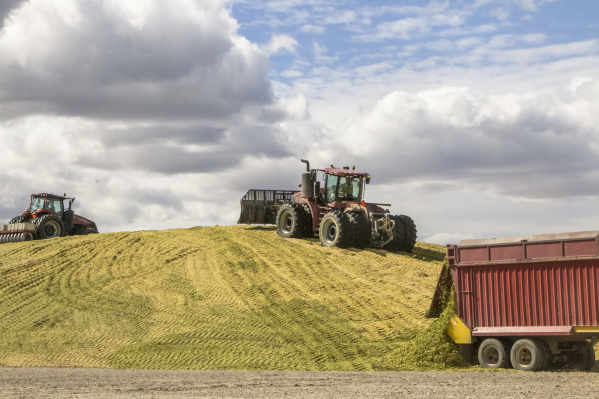As we look ahead to the upcoming silage harvest and these volatile grain and commodity markets, how can we take our harvest, storage and feedout practices and improve our efficiencies to improve our bottom lines?
It has been shown through on-farm trials and farm data programs, along with university research, that a well-managed farm is expected to have 14% to 16% total shrinkage in fermented feedstuffs. That is the average, meaning some operations may see 10% while others may see 30% or greater.
Total shrinkage is the loss of that feedstuff during harvest, transport and packing. Respiration and oxidative loss can occur during fermentation, so when the microbes both naturally formed and inoculant formed, they start to break down plant material and nutrients for preservation and storage. There will then be spoilage losses, seepage losses and feedout losses, including wind, rain, equipment, facing, etc.
With the current value of corn, other grains and commodities, there could be a chance your silage may be valued at $40, $50, $60 or more per ton this year.
In Table 1, you can see for every 1,000 tons of silage harvested at 15% shrinkage, you will have 850 tons left over.

Table 1 also shows the economic loss at a potential value per ton of silage. So over the last two years, we could potentially see silage value doubling, resulting in the shrinkage value also doubling. No matter if you only put up 1,000 tons or 10,000 tons of silage, you could be losing up to twice as much money for the same shrinkage as previous years. A 10,000-ton harvest could potentially be losing up to $90,000 this year alone, which is almost double from one or two years ago. Maybe the question should be asked: Are you getting two times more money for the milk, beef or product you are selling?
The next big question to ask is: If 14% to 16% shrinkage is average, is there even a way to reduce that? The short answer is: yes. Again, that is the average, so that means there are operations out there that consistently get less shrinkage than average. On the other hand, that means there are many operations that get more.
If you are reading this and thinking, “Maybe we are fine, we do most things almost right or best as we can, we might take a few shortcuts or maybe we don’t spend enough time doing something because we are too busy or try to save a few bucks,” remember that this is your feed for the next year, and it is one of the most important things on your operation. You cannot save your way to prosperity.
Let’s use a hypothetical example of our neighbor, and we’ll call him Jerry. He is known for his “thriftiness” of cutting costs and corners. He doesn’t believe in using plastic to cover his silage, doesn’t want to climb out of his tractor to hook up the facer, harvests when he feels like it because he forgot to do maintenance on the equipment over the winter or didn’t want to replace a part he should have because he thinks that equipment dealer is overpriced; he definitely won’t use an inoculant. But does Jerry know what he is really losing?
Uncovered silage with no plastic covering can have an additional 10% to 30% increase in shrinkage on top of total shrinkage. That shrinkage comes mainly from the increase in spoilage, as 1 inch of spoilage used to be 2 to 4 inches of good feed. So for the operations out there that have 1 foot of spoilage, that could have been 2 to 4 feet of good silage. That results in poorer fermentation and more unstable silage and shrinkage. There could also be more abnormal fermentation compounds, which can cause poor animal performance. Poor fermentation compounds and spoilage will impact animal production and health with feeding that silage.
In Table 2, we are looking at increasing shrinkage to 25%, which is average for poorly managed forages, such as Jerry from our hypothetical example above. It can be expected to lose between $10,000 and $15,000 for every 1,000 tons of silage put up.

At the end of the day, you may still be achieving record milk output, high average daily gains and healthy calves, but that invisible shrink we don’t notice or monitor closely can be costing you thousands and thousands of dollars each year. Then, when years like this happen with higher prices and operations trying to be more efficient, that shrinkage may cost twice as much as it did last year. So always remember to do the basics when it comes to forage management.
Harvest at the correct times and optimal moisture, pack and pack some more, stay on that pile, use inoculants as they are proven and well researched, and utilize top spray-on treatments. The greatest return from saving shrinkage losses is to effectively cover with plastic, as it will save you money by preserving important nutrients in the silage and maintaining the quality of the feed.







